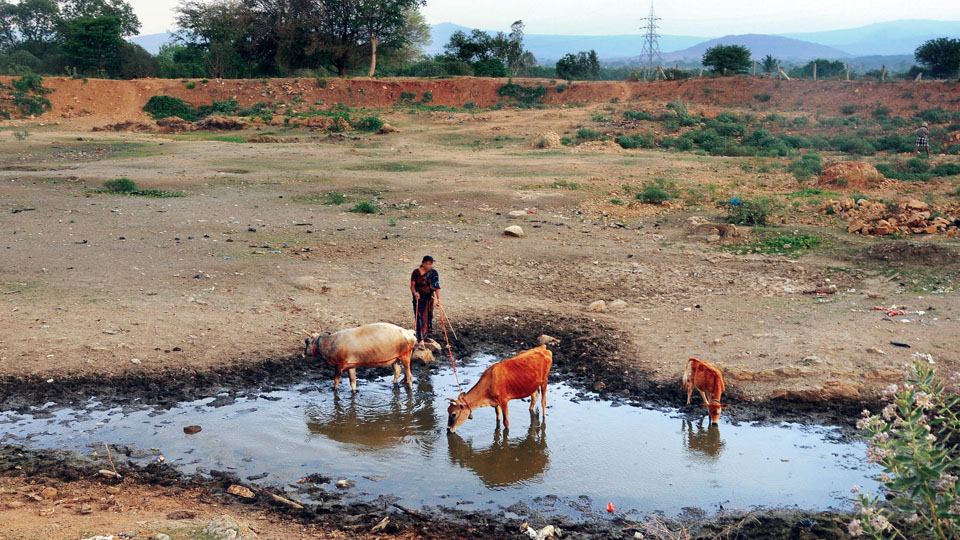
Summer is here and water woes are set to begin as water levels in KRS and Kabini Reservoirs are steadily diminishing.
But not to worry, the Mysuru City Corporation (MCC) is prepared like it always is with, unfortunately, a temporary solution. But when will we get a permanent solution?
The MCC, realising that the KRS Dam has water only to last us two months, has devised a strategy — the same old strategy — utilising private borewells and water tankers.
Similar measures have been taken in Bengaluru. Yesterday, anticipating drinking water crisis in the coming days, Revenue Minister Krishna Byre Gowda said the Government has called for tenders to supply drinking water through private tankers.
Every Government, be it Congress, BJP or JD(S), never tries to find a permanent solution to this water problem, why? Because there is money to be made in a water crisis?
Now, borewell owners and tanker owners will make money, and most of them will be connected to the ruling party. Not to forget the compensation they will claim from the Union Government in the name of drought.
If the Government is serious about solving the water problem — both water shortage and flooding — then it is time to look at lake conservation seriously.
This attitude of ‘temporary’ fix cannot go on forever. Ground water has already dropped drastically over the years. With more layouts coming up, with more deforestation, Mysuru will end up like Bengaluru — a city with bad air and no water.
Bengaluru, a city that was once called ‘The land of a 1000 lakes’ and known world over as the ‘Garden City’, today is number two on a United Nations list of cities that will run out of drinking water in the next 15 years !
Yet none of the Governments have come up with a long-term plan to solve this basic problem. But our Dy. CM wants to visit Singapore to learn how to make underground tunnel roads instead of rejuvenating lakes.
Our kings and ‘colonisers’ took better care of our cities than our leaders in Independent Democratic India. Here’s an example of what they did to fulfil basic perennial need of Bengaluru — water.
Bengaluru has no perennial river close and the city is 3,000 feet above sea level. So, both Kempe Gowda, the founder of Bengaluru, and later Lieutenant-General Sir Richard Hieram Sankey (after whom Sankey Tank is named), developed a system called ‘Cascading of Lakes.’
This was a natural rainwater harvesting system wherein the rain water is collected first in the lakes at the higher level and once these filled up, it flowed to the lakes in the next level via 30-ft wide inlets called Raja Kaluves.
When the second-level lakes also filled up, the surplus flowed to the third-level of lakes and so on till the excess water from the last level of lakes flowed into the four natural drainage valleys of Challaghatta, Koramangala, Hebbal and Vrishabhavathi.
The system was so efficient that when the Captain of the British East India Company came to Bengaluru he described it as the ‘Land of a thousand lakes.’ But today, how many lakes do we have in Bengaluru?
According to a 2013 report submitted by V. Balasubramanian, a former Additional Chief Secretary, Government of Karnataka, titled ‘Death of Lakes and the Future of Bangalore’ he notes “There are now only 189 tanks that are ‘live’ but these ‘live’ tanks are only storing sewage waste water which is causing groundwater contamination.”
Our Government does not understand the importance of lakes in making a city liveable. That is why the Government irresponsibly constructed a hockey stadium on Akkithimanahalli Lake, converted Dharmambudhi Lake into Kempegowda Bus Stand, turned Sampangi Lake into Kanteerava Sports Complex and built a National Games Village on Koramangala Lake.
When the Government itself sees lakes as potential real estate, our cities will go thirsty during summer and will flood in monsoon.
Mysuru too is headed the Bengaluru way. May be, that is why Rohini Sindhuri, former DC of Mysuru, had declared protection of Government land and lakes as her priority for Mysuru.
In Mysuru, many grand lakes have been killed by an indifferent administration.
Jeevannarayana Katte, which is now called J.K. Grounds was a small lake. It went dry as buildings came around it, and the feeder channels were blocked.
Then there is Doddakere Maidan in front of the Palace; it suffered the same fate.
Subbarayanakere in front of Shantala Theatre also used to be a lake; now it’s dry too. Even the channels to Kukkarahalli Lake are covered hindering fresh water flow.
Then there are other lakes in the city that have been slowly encroached upon, like Lingambudhi Lake near Vivekananda Nagar, Devanur Lake in N.R. Mohalla and lakes on Nanjangud Road.
Numerous water bodies on the outskirts of Mysuru going towards Hunsur have been covered, and now Choultries sit pretty on them.
Even the Yelethota that leads to Nanjangud Road was a swamp that sucked up water preventing flooding. It is now being sold to builders. So where is the rainwater supposed to go? Obviously, into our homes.
As Mysuru grows, lakes will become important. Lakes can ease the impact of floods and droughts by storing large amounts of water while also replenishing groundwater.
Already the depth to which we have to dig a borewell for water has gotten deeper. It will only get worse if we do not preserve our lakes.
This means we need an organisation for urban planning…Oh ! but we do have one, it’s called MUDA (Mysuru Urban Development Authority) and lake rejuvenation and protection doesn’t figure in its priority list. We are doomed.
e-mail: [email protected]








Recent Comments